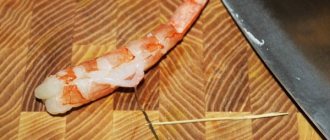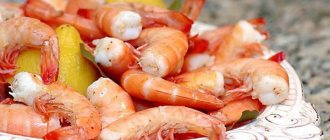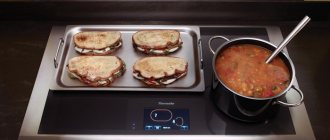Sometimes you want to cook a gourmet restaurant dish to add variety to your diet and pamper yourself and your family. Shrimp are perfect as a healthy delicacy for gourmets. Cooking seafood is becoming more and more popular: they are tasty, healthy and unusual.
Shrimp meat has a number of beneficial properties. It is hypoallergenic, rich in vitamins of all groups, rich in magnesium and iodine, it contains a large amount of protein and virtually no fat, which makes shrimp an ideal choice for dietary nutrition.
Cooking shrimp is not difficult, however, it is a very delicate product, and if you do not take into account all the cooking features, you can ruin it. Let's figure out how to properly and tasty cook shrimp at home, no matter what exotic recipe you choose.
Types of shrimp
To date, more than 2,000 species of shrimp have been officially registered in the waters of our planet, from very tiny ones, two to three centimeters long, to huge half-meter specimens. However, there are mainly several types of these seafood on store shelves. Let's list the most popular ones.
1. Argentine shrimp. In accordance with the name, this type of shrimp is caught near Argentina. They can be distinguished by their bright red shell, which is more typical of boiled delicacies. People often call them “sweet shrimp” due to their light and unobtrusive sweetish taste.
2. “King” shrimps. Officially, such shrimp do not exist in nature, however, it was invented as a marketing ploy for the largest and fleshiest specimens of various species of these crustaceans. Individuals caught in the natural environment are quite different from shrimp raised on special farms: both in size and taste. On store shelves, “king” shrimp can usually be found either fresh frozen or boiled-frozen.
3. Tiger prawns. They can be distinguished by their enormous size and the stripes on their shells that give them their name. Tiger shrimp are mostly farmed. You can always find them on sale either frozen, boiled-frozen, or chilled.
4. Northern or Atlantic shrimp. These are the smallest shrimp among all other representatives of their species available for purchase. The largest specimens reach a length of about 10-11 centimeters. During transportation, these shrimp are always frozen to preserve their flavor.
Since our country is quite remote from the most common fishing grounds, shrimp are usually delivered frozen.
Shrimp are frozen before shipping either raw or pre-boiled, which is why the technology for preparing the shrimp will be different.
Seafood
What are the benefits of shrimp and what can be cooked from them?
What are they selling us?
When wondering how long to cook shrimp, you should first think about choosing the right product. To do this, you need to tighten up the theory a little.
Varieties
Looking at the shrimp offered in stores, you will notice that they all differ in color, size and price. These factors are determined by the variety of crustaceans, the table below will help you get an idea of which.
Table - Varieties of shrimp
| View | Peculiarities | Main suppliers |
| Atlantic (cold water) | — Small size; - more affordable price | - Canada; — Baltic States; — Scandinavia |
| Warm water (royal and tiger) | — Large size; - high price; - bred artificially on special farms or in the natural environment | — China; — Thailand; — Indonesia; — Vietnam |
| Argentine | — Lives in the natural environment, is not artificially grown; - pronounced sweetish taste; - bright red shell; - low cost | - Spain; — Argentina |
| Azovskaya | - Very small size; - pronounced sweetish taste | Russia |
| Vannamei | — Produced artificially; - low cost; - looks larger than the Atlantic; - bright color | China |
In European countries, Atlantic shrimp is considered more tasty and healthier, as it grows in natural conditions. Previously, this product was more expensive, but now, due to changes in the economic situation, farmed crustaceans are more expensive. However, there is information that some Asian manufacturers use antibiotics and dyes to improve the presentation of the delicacy.
Size
The size of shrimp is called caliber. This unit measures the number of individuals per kilogram of weight. For peeled crustaceans without heads and shells, the size is indicated not per kilogram, but per foot (about 450 g). The table below gives an idea of the size of popular species.
Table - Shrimp size
| View | Caliber |
| Atlantic | — 50-70; — 70-90; — 90-120; — 120+ |
| Tiger | — 2-4; — 4-6; — 6-8; — 8-12; — 12-16; — 16-20; — 21-30; — 31-40 |
| Argentine | — 21-30; — 30-55 |
If instead of the size on the package there is a No name marking, this is a trifle, a remainder, a mismatch.
Selection rules
Just a couple of decades ago, shrimp were considered an exotic delicacy that was not easy to obtain. Now seafood can be bought at your nearest supermarket. However, among the widest assortment, there are low-quality goods. Four recommendations will help you make the right choice.
- Transparent packaging. You shouldn’t take a pig in a poke – give preference to products packaged in transparent packaging. It is better to buy the product in a sealed bag rather than in bulk.
- A layer of ice. After catching, the shrimp are immediately frozen. Therefore, a layer of ice on seafood, the so-called glaze, is normal. However, the thickness of the “growth” should not be more than 1 mm. If this layer is too thick, one suspects that the crustaceans were deliberately soaked in water to increase weight. In accordance with GOST, the ice content should not exceed 4%.
- Snow. If there is snow in the package, the product was defrosted and then frozen again - such “therapy” negatively affects the taste of crustaceans.
- Standing out "individuals". Among the general mass of uniformly colored shrimp, you can sometimes see crustaceans that differ in appearance. The table below will tell you why the shrimp looks different from its “neighbors” in the package, and whether such crustaceans can be eaten.
Table - What shrimp “talk” about
| Sign | What does this indicate? |
| Whitish or yellowish crustaceans | The product is stale |
| Brown | Pregnant individuals, their meat is very valuable |
| Straight rather than curled tail | — The shrimp died before it was frozen; — freezing technology was not followed |
| — Black spots on the body; - black head | Sick individual |
| Green head | The shrimp fed on plankton and is suitable as food |
| White spots | Violation of the freezing regime |
The uniform color of the crustaceans, shiny, smooth shell is evidence of the good quality of the product.
How to cook frozen shrimp
Often you can find frozen shrimp in the store. Fresh frozen shrimp have a grayish-green tint (except for some species, such as Argentine shrimp, which have a red color) and need to be cooked longer.
Step 1: Preparing Ingredients
To cook shrimp, you will need the seafood itself, a suitable container, water and salt. The amount of water you need to take is twice the amount of shrimp.
Step 2. Defrosting shrimp
Shrimp will not cook evenly if not thawed before cooking. To defrost them, place a bowl of shrimp under cold running water. The water should be cold; hot water can ruin the taste of the product.
Step 3: Rinse the shrimp
Before cooking, rinse the shrimp under running water to remove undefrosted ice and excess debris.
Step 4. Preparing the water
Boil water in a large saucepan adding salt. The richness and flavor of the broth can be enhanced by common spices and herbs used in the kitchen.
Step 5. Boil the shrimp
When the salted water reaches the desired temperature, lower the shrimp into it. Cook seafood over low heat. Small shrimp are cooked for about 2 minutes, and larger ones for 4-6 minutes. Once the color of the shrimp changes to a brighter color, they should be quickly removed from the heat.
Step 6. Submission
Pour the cooked, freshly cooked shrimp into a container filled with ice cubes. The shrimp are ready, now you can divide them into portions and serve them immediately.
Subtleties of cooking
To make shrimp meat tender and tasty, you need to cook it following certain rules:
- Natural thawing of the product before cooking plays an important role in the process. Defrosting shrimp in hot water or in the microwave is highly not recommended. Excessive thermal exposure makes the meat not juicy and rubbery.
- You only need to immerse the shrimp in boiling water. They should not be subjected to slow heating by initially filling them with cold water. In this case, all the beneficial substances will go into the decoction, and there will be no talk of any nutritional value of the product.
- To obtain a richer taste and aroma, you can add spices and seasonings during cooking. It is better to use bay leaf, rosemary, basil, Provençal herbs, black and/or red pepper for these purposes.
- The readiness of the product is indicated by the color of the shell of the emerging shrimp. If it becomes transparent, the crustaceans can be removed.
Important! It is necessary to strictly observe the cooking time of shrimp. Overcooked, they become tasteless and take a long time to chew.
No wonder this delicacy is suitable for quick meals. It only takes a few minutes to be ready. So, medium-sized Atlantic shrimp will need to be boiled for only 3 - 4 minutes . Royal and brindle 5 – 6 minutes . Frozen, unpeeled 7 – 10 , peeled – 5 minutes . The smaller the crustaceans, the faster they cook. It is worth remembering that freshly frozen shrimp will need to be cooked 2 - 3 minutes longer than already boiled ones.
There are many ways to cook shrimp. They can not only be boiled, but also fried in a frying pan, cooked in the microwave and in a double boiler.
How to cook boiled frozen shrimp
Boiled-frozen shrimp are often small in size. They are boiled directly on the ship, after which they are frozen using blast freezing. Typically, these shrimp have flesh that is not transparent, but pink in color. Boiled-frozen shrimp can be consumed immediately after defrosting.
Step 1: Preparing the Shrimp
It is necessary to take into account that boiled frozen shrimp are already ready; they just need to be well processed, rinsed under a strong stream of cold water and rid of excess ice and debris.
Step 2. Boil the shrimp
To revive the taste and aroma of boiled frozen shrimp, you need to immerse them in boiling salted water with added spices for 1-2 minutes.
Step 3. Submission
When the shrimp are completely cooked, their shells will become translucent. Drain the seafood in a colander and sprinkle with lemon juice to enhance the flavor.
Photo: pixabay.com
How to cook fresh shrimp
Fresh shrimp can very rarely be found on store shelves, as it is a perishable product. Fresh shrimp must be cooked the day of catch, so you need to be careful when choosing shrimp.
Step 1: Selecting Shrimp
The most important step when preparing fresh shrimp is selecting them. Give preference to shelled crustaceans, because they are usually easier to identify spoiled specimens. Also, shrimp should not smell of ammonia; a bad smell is the first sign of unsuitable products.
Step 2: Preparing the broth
Boil water over high heat, and once boiling, add salt. If desired, you can also add spices, but some people prefer to do without them so that the delicate taste of the shrimp is not interrupted by other flavors.
Step 3: Cooking the Shrimp
Place fresh shrimp in boiling salted water and cook for 6-7 minutes over medium heat if they are small, and about 10 minutes if they are large. Do not add time to the recommended values, otherwise the shrimp may turn out tough and tasteless.
Features of choice
As a rule, shrimp reach store shelves frozen. The product is frozen immediately after catching in raw or boiled form. When purchasing this delicacy, you need to remember a series of nuances:
- The first step is to carefully examine the packaging. It must indicate the manufacturer, his contact information and the date of packaging.
- To carefully examine the product and evaluate its quality, it is best to buy shrimp in bulk or in transparent packaging.
- Crustaceans that have been stored for too long can be identified by sight. They are characterized by: a dried out shell, dark spots on the legs and yellow meat.
- High-quality shrimp have an even color and a tucked tail. If the tail is straightened, this indicates that the individual died before the primary processing process. In this case, the freshness of the product cannot be guaranteed.
- The presence of snow in the package indicates that the shrimp have been re-frozen. Because of this, they lose their nutritional and taste properties.
- Crustaceans with black heads are not suitable for food, as this color indicates illness. There are also shrimps with green heads; there is no need to discard them. These crustaceans got their color from the special plankton they fed on.
- Indicating the quantity of products per kilogram is also important information. By the markings on the packs you can understand how many shrimp are contained in 1 kg of product (the main size and quantity categories are presented in the table below).
| Marking | Size and quantity per 1 kg |
| 120+ | The smallest (more than 120 pcs.) |
| 90/120 | Medium (from 90 to 120 pcs.) |
| 70/90 | Large (from 70 to 90 pcs.) |
| 50/70 | Very large (from 50 to 70 pcs.) |
Choosing quality shrimp is half the battle. The most important thing is to cook them correctly.
How to cook unpeeled shrimp
It is believed that unpeeled shrimp have a more pronounced flavor palette. If you cook unpeeled shrimp correctly, the dish will have a rich aroma and a mild taste.
Step 1: Preparing Ingredients
Required ingredients: seafood, lemon, herbs, pepper and salt. The amount of ingredients should be determined by eye and adjusted during cooking.
Step 2. Boil the shrimp
Pour all the ingredients into boiling water and then boil the shrimp in the resulting marinade until tender. On average, small unpeeled shrimp take approximately 6-7 minutes to cook, larger shrimp about 10 minutes. After the seafood has floated to the surface and acquired a pink-reddish tint, it must be removed from the marinade.
Step 3: Clean the shrimp
Cool the finished shrimp and remove the shell. To clean crustaceans, you need to very carefully cut the shell along the back, and then also carefully pull out the black intestinal thread.
Step 4: Submission
Peeled shrimp can be served with the marinade remaining after cooking, or separately as an independent dish.
This is interesting
Squid: healthy seafood in your everyday diet
How to cook shrimp with dill at home?
One of the simple ways to tasty boil shrimp is by adding dill. Greens will give the treat a special aroma. Use a proven homemade seafood recipe.
Cooking time: 20 minutes
Cooking time: 10 minutes
Servings – 4
Ingredients:
- Shrimp – 1 kg.
- Salt – 1 tbsp.
- Dill – 20 gr.
- Bay leaf – 3 pcs.
- Black peppercorns – 0.5 tsp.
Cooking process:
1. Prepare the necessary spices. We wash and chop the dill; it can be fresh or frozen.
2. Boil water in a saucepan and dissolve salt in it.
3. We also put spices and chopped dill here. Boil the mixture for one to two minutes until the color changes and a slight aroma appears.
4. Measure out a kilogram of shrimp.
5. Transfer the seafood to boiling brine. Cook it for about 7 minutes.
6. Remove the finished shrimp from the water and transfer them to a plate. The treat is ready to serve!
Report a bug
How to cook king prawns
“King” shrimp can be distinguished by their large size: because of this, seafood takes longer to cook.
Step 1: Preparing the Shrimp
Most types of shrimp are cooked using a similar technology, however, when cooking different types, some nuances are taken into account. When preparing king prawns, it is also important to defrost them well and de-glaze them so that they can cook evenly in the marinade.
Step 2. Boil the shrimp
The recipe is not as important as the cooking time. “King” shrimps need to be boiled for 8-10 minutes at a constant boil. As soon as they acquire a uniformly reddish tint, they can be removed.
Step 3: Clean the shrimp
After cooking, king prawns must be peeled. To make it easier to remove the shell, place the seafood in cold water for a short time. After this, the shrimp can be served.
Delicious and simple shrimp recipes
Shrimp are a great option when you want to add variety and cook something original and exotic. They are often used in restaurant cooking due to their ease of adaptation to different cuisines: shrimp are served both in Asian cuisine with ginger and sweet chili sauce, and in a light Italian salad with Parmesan. A few simple recipes that you can easily repeat at home will help surprise your household, saving your time for more pleasant chores.
Garlic shrimp
Photo: pixabay.com
| Butter | 10 g |
| Grated parmesan cheese | 5 g |
| Ground black pepper | taste |
| Salt | taste |
| Greenery | 2 g |
| Garlic | 1 clove |
| Peeled shrimp | 120 g |
| Lemon juice | taste |
| Olive oil | 10 ml |
Add butter and olive oil, thinly sliced garlic to a heated frying pan, fry, and after it gives off the aroma, place the peeled shrimp in the frying pan. Fry for 7-10 minutes until done. Before serving, place the shrimp on a plate, drizzle with lemon juice and sprinkle with chopped herbs and Parmesan cheese.
Share your recipe
Send the recipe for your signature dish to the mail "Komsomolskaya Pravda" will publish the most interesting and unusual ideas
Share
Battered shrimp recipe
Photo: pixabay.com
| Peeled shrimp | 250 g |
| Flour | 100 g |
| Egg | 1 PC |
| Cold water | 100 g |
| Dry parsley | 2 g |
| Olive oil | 10 ml |
| Salt pepper | taste |
In a deep bowl, mix flour, parsley, salt, pepper, egg and cold water until smooth. After this, you need to pour the shrimp into the resulting batter, mix everything well and place it in a prepared heated frying pan with olive oil. Fry for about three minutes until they turn golden. Fry on both sides and then place on a dry paper towel to remove excess oil. The finished dish can be served with lemon wedges or tartar sauce.
Recipe for aromatic salad with shrimp and avocado
Photo: pixabay.com
| Avocado | 1 PC |
| Shrimps | 100 g |
| Lettuce leaves (any) | a handful of |
| Olive oil | 10 ml |
| Lemon juice | taste |
| Garlic | clove or to taste |
| Red salad onion | 1/4 head |
| Cilantro | 2 branches |
| Almonds | 1 teaspoon |
| Salt pepper | taste |
The shrimp must be peeled, leaving the tails, and boiled until tender. Peel the avocado, cut into slices, then sprinkle with lemon juice. Onion, garlic and cilantro need to be finely chopped. Mix all available ingredients in a deep bowl. Before serving, you can add salt and pepper to taste.
Chef's Tips
Chef Pavel Kuptsov gives several life hacks on how to properly cook shrimp
There is an easy way to assess the degree of readiness of shrimp: if the shrimp is straight, it is not ready yet; if the shrimp has curled in the shape of the letter “C,” the seafood can be served. If the shrimp is curled into a ring, it means it is already overcooked. There is no need to cook these delicacies for too long so as not to lose their taste.
Shrimp broth can always be strengthened with the usual universal seasonings, and if one third of the broth is replaced with white wine, then during the cooking process the shrimp will be saturated with its aroma.
You should not get rid of seafood heads and shells if you cleaned the shrimp before cooking. If you boil them with salt, herbs and vegetables, you will get a wonderful broth from which you can make shrimp soup.
Popular questions and answers
To understand all the intricacies of the cooking process, together with Pavel Kuptsov, we will answer popular questions about how to properly cook and serve shrimp.
What spices can you add to shrimp?
Usually, when preparing shrimp, light seasonings are used to only highlight their delicate taste. The most suitable ingredients for cooking shrimp are black pepper, bay leaf, cloves and garlic. Also, various herbs such as rosemary, cumin or basil are often used during the cooking process.
What sauce goes with shrimp?
Usually shrimp are served with garlic, honey-soy or tartar sauce. But sometimes, for example, in Asian dishes, it is served with sweet chili or teriyaki sauce.
Blitz history of shrimp in Russia
The popularity of shrimp began when someone came up with the idea of sending shrimp to pubs as a snack.
In stores they were sold either in boxes or by weight, the price was quite moderate, if I’m not mistaken, 1 ruble 43 kopecks per kilogram, you could afford it. Like almost everything else, shrimp were in short supply, especially in boxes; buying them was considered good luck. Shrimp were supposed to be eaten in company, of course, with beer. In beer shrimps, shrimps were cooked continuously in large cauldrons, scooping out ready-made ones and adding frozen ones as they were parsed, which is why they were often overcooked and became flabby. They didn’t bother with any spices; at best it could have been a bay leaf. Only in the Rakushka beer hall in the south-west of Moscow did they add a fair amount of red pepper. Evil tongues claimed that the reason was to drink more beer. This, of course, is nonsense. It was simply impossible to drink even more beer; one could only speed up the process.
Shrimp with beer - a common Soviet-era stereotype
But at home, shrimp were cooked with more creativity. Everyone had their own secret recipe. Once, in front of me, a beautiful girl boldly poured half a bowl of sugar into boiling water for shrimp. “That’s how it should be,” she said confidently. Dill, black and red pepper, bay leaf, less often onion, and even less often lemon were added.
At that time, no one knew how to properly deal with shrimp, and since then, there haven’t been many more experts. The original version from the 70s continues to be the most common.











